 Kwanwoo Jun A man prays at the grave of a relative who
Kwanwoo Jun A man prays at the grave of a relative who
was buried in 1830.Two of the New York Marble Cemetery’s vaults may soon be reclaimed and put up for sale for the first time since 1830.
The cemetery hasn’t seen a new burial since 1937. But that may soon change. On July 15, its operators will ask the New York State Department of Cemeteries if they can reclaim two of its graves. In New York, a vault may be reclaimed if it is empty, if there has been no contact with the owners for over 75 years and if no owners can be found after diligent searching and advertising. Read more…
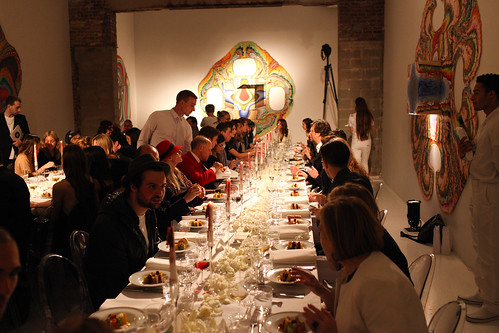 David X Prutting/BFAnyc.com The Hole’s dinner for Dior Vernis.
David X Prutting/BFAnyc.com The Hole’s dinner for Dior Vernis.After blurring the line between art and landscaping, The Hole is now bending the boundaries between art and food. Last night, the Bowery gallery held a dinner party that introduced attendees to the medium of “pour painting,” and this summer, The Local has learned, it will open a pop-up “artist cafe,” cheekily dubbed Hole Foods.
The pop-up cafe is in part the vision of The Hole’s founder, Kathy Grayson, who described herself as an arm-chair restaurant critic and food blogger. “I had never seen an artist-designed restaurant, only restaurants with a few sad paintings on the walls,” she told The Local. “I thought that the artists I represent are all interdisciplinary and are capable of doing not just painting and drawing but sculpture, video, design, installation, furniture, you name it.”
On Wednesday, the Meatball Factory temporarily closed on 14th Street and Second Avenue so that Brooklyn-based artist Joe Grillo could install a mural on its walls, ceilings, and floors. Read more…
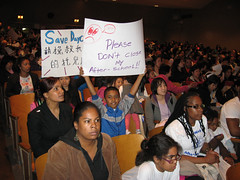 Stephen Rex Brown One of the many students at yesterday’s rally against the cuts to after-school programs.
Stephen Rex Brown One of the many students at yesterday’s rally against the cuts to after-school programs.A panoply of politicians blasted Mayor Michael R. Bloomberg’s proposal to slash funding for after-school programs citywide yesterday, saying the cuts would have a particular impact on the Lower East Side.
“It’s outrageous,” said Councilwoman Margret Chin, whose district would lose seven out of 10 of its after-school programs if Mr. Bloomberg’s budget proposal is approved in its current form. “He needs to look at these kids and say, ‘You don’t count.'” Read more…
The conflicts over the future of two of the city’s most revered academic institutions rage on. Over in Greenwich Village, add Bloomberg’s architecture critic to the list of people not fond of N.Y.U.’s expansion plans. “For a while I thought these expressionless shapes were simply cartoon placeholders for real buildings that could be developed with a great deal more sensitivity,” reads the hard-hitting review. And over at Cooper Union, students have begun a petition drive in support of an alternative plan, dubbed “The Way Forward,” that suggests ways to raise revenue without charging students tuition.
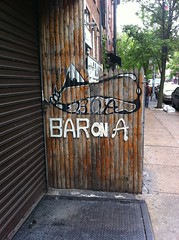 Daniel Maurer The bar at 170 Avenue A.
Daniel Maurer The bar at 170 Avenue A.Once again, it’s neighbor versus nightlife: Bar on A is locked in a battle of wills with an upstairs tenant who has frequently complained to city authorities about what she says is “extreme noise.”
However, a person associated with the 17-year-old watering hole, which opened around the same time as the recently shuttered Lakeside Lounge, blames the neighbor for incessant complaints which he says have cost the establishment tens of thousands of dollars in revenue and even resulted in a police raid.
Mitch, an associate of Bar on A who did not want to be identified by his last name owing to the bar’s delicate situation, blamed the present conflict on “this nuisance neighbor who’s abusing the 311 system and recruiting people like a vigilante to hang us and hang everybody else in the neighborhood.” Read more…
 Stephen Rex Brown The Mars Bar site today
Stephen Rex Brown The Mars Bar site todayThe Department of Buildings smacked a partial Stop Work Order on the former Mars Bar site today. A sign posted on the plywood construction fence at First Street and Second Avenue, where a 12-story condo is being erected, indicates that “all chopping and saw cutting on foundation walls” must cease.
It’s uncertain what provoked the order (we’ll let you know what we hear from the D.O.B.), but it isn’t the first hiccup at 25 East First Street. According to paperwork, a partial Stop Work Order was served last month after the Department of Buildings received a complaint that a crane appeared to be unsafe, and an inspector found that the project’s engineer of record hadn’t signed off on it. That issue has now been resolved.
In December, before the dive bar was toppled, another stop work order was issued after a worker was injured during a ceiling collapse.
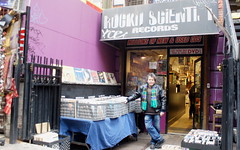 Suzanne Rozdeba Joe Barbosa had been selling records outside of the store.
Suzanne Rozdeba Joe Barbosa had been selling records outside of the store.Earlier today, John Kioussis hauled a turntable and a few remaining crates of records out of an empty, darkened storefront at 33 St. Marks Place. Before locking up the narrow nook that has housed Rockit Scientist Records since 2003, he said he had closed in part because of squabbles with one of his landlords.
Mr. Kioussis let forth a litany of complaints about Amnon Kehati, a co-owner of the building (which is for sale) and of Mark Burger next-door: he had set up tables in front of his store without asking, made unreasonable complaints about garbage bags being left out, and accused the record store of attracting rats.
“The reason we have rats in the building, according to the landlord, is because I have records downstairs and rats are attracted to records,” Mr. Kioussis said as he cleared out his shop. “I wonder what scientist would tell you that Bob Dylan and Sex Pistols records attract rats as opposed to bags of tomatoes and onions all over the floor.” Read more…
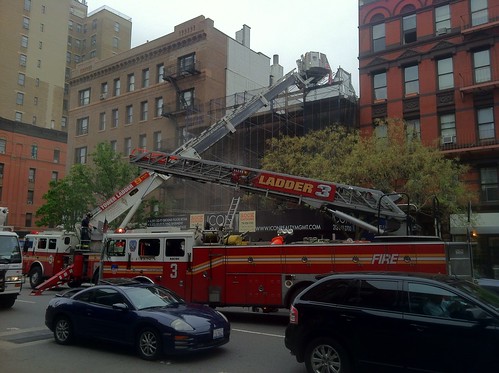 Stephen Rex Brown The scene at 152 Second Avenue at around 1:30 p.m.
Stephen Rex Brown The scene at 152 Second Avenue at around 1:30 p.m.Workers building a three-floor extension to 152 Second Avenue put out a minor fire at around 1:30 p.m.
A pair of workers at the site said that the fire was little more than a spark from an open gas line.
“They had a fire extinguisher handy and it went out right away,” said Battalion Chief Jim Tracy.
For every East Village business that’s opening or closing, dozens are quietly making it. Here’s one of them: Essex Card Shop
 Shira LevineM. Aslam (left) and Jayant Patel (right) outside of their store.
Shira LevineM. Aslam (left) and Jayant Patel (right) outside of their store.Twelve years ago, Jayant Patel came to the East Village for cheaper rent (yes, your read that correctly), after the monthly dues were hiked at his 12-year-old stationery store at 116th Street and Broadway. Back then, the rent in the city-owned building at 39 Avenue A was $3,500. It’s now $5,800, and the modest paper store has expanded to include items like printer cartridges, socks and baby clothes. Five years ago, Mr. Patel, who is Indian, partnered with M. Aslam, a Pakistani immigrant. Not only are the two of them making it at Essex Card Shop (and at their other store, Village Stationery on LaGuardia Place), but as Mr. Patel revealed to The Local, a movie is being made about his life story.
Q.
There is a lot of quirkiness in here, with thoughtful quotations you’ve pasted here on the counter. What is your philosophy on life?
A.
Mr. Patel: My philosophy is “truth, love, and honesty.” It’s universal. Trust is something everyone follows. If you are truthful then people will trust you. I see myself as Muslim, Hindu, Christian, all in one. If you’re nice to people, people are friendly. People in New York are good. New York is a tough town, but it’s full of good people if you stop and experience it. Life is hard and not always comfortable. Struggle makes you strong and I don’t mind it. Read more…
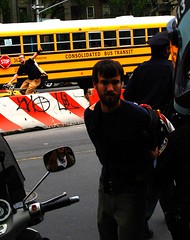 Tim Schreier Protester arrested at Sara D. Roosevelt Park
Tim Schreier Protester arrested at Sara D. Roosevelt ParkWhen we filed our final report on May Day activities in the wee hours of this morning, the police would say only that more than 30 were arrested during yesterday’s demonstrations. The final tally is now in: City Room reports that 34 people were taken into custody and another 52 issued desk appearance tickets.
The photo above is one of Tim Schreier’s newly posted shots from the Wildcat March at Sara D. Roosevelt Park. And arrest videos have also emerged on YouTube. A video posted by Kg4 shows a protester kicking out a police car window from inside of a cruiser. Read more…
Photos: Scott Lynch
Good morning, East Village.
Yesterday we spent 19 hours live-blogging May Day activities throughout the city: you can find our initial report here and our follow-up here. There was even a David Byrne cameo. Now a video of one of the arrests has popped up on YouTube (hat tip to Google Alerts). And above, here are Scott Lynch’s photos of Tom Morello’s “guitarmy” in Bryant Park and the festivities at Union Square.
Elsewhere: More Than Usual spots a swastika on the construction plywood at 51 Astor Place.
Jeremiah’s Vanishing New York discovers that sculptor Randy Hage has created a miniature version of Mars Bar. Read more…
Photos of the march across the Williamsburg Bridge, Sara D. Roosevelt Park, and the Wildcat March by Jared Malsin.
As documented on The Local’s liveblog, demonstrations and arrests took place across the city today as anarchists, union members, Occupy Wall Street supporters, employees of The Strand, residents of public housing in Alphabet City, and even banjo players used May Day as an occasion to protest the status quo.
The proceedings were for the most part orderly, but scuffles broke out when approximately 200 demonstrators, many dressed in black and some covering their faces, assembled in Sara D. Roosevelt Park, at Second Avenue and Houston Street, at 1 p.m. for a pre-planned, unpermitted “Wildcat March.” Read more…
Today on The Local, we’re not only looking back at the May Day riot of 1990 (stay tuned for more on that), we’re also on the ground at a number of events planned city-wide and in the East Village. Below, you’ll find real-time updates from our reporters Jared Malsin (@jmalsin) and Evan Bleier (@itishowitis), as well as our contributing photographers Tim Schreier, Scott Lynch (@scoboco), Susan Keyloun, and others. We’ll also be linking to other online coverage. E-mail us, Tweet at us, or leave a comment if you have tips or want us to follow you on Twitter. And if you have photos to share, add them to our Flickr group.
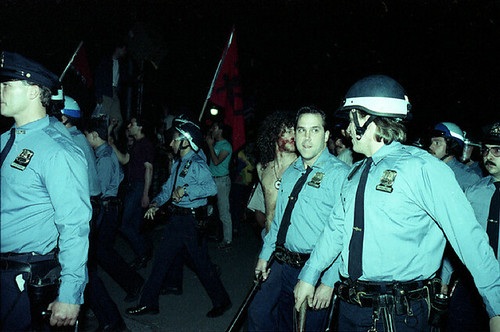 John Penley
John PenleyBefore today’s May Day festivities kick off, let’s turn the clock back 22 years, to May 1, 1990. That’s when an affordable-housing festival in Tompkins Square Park ended in a riot in which 28 police officers were injured and 29 people – some of them activists, anarchists, and squatters who had participated in the better known riots two years earlier – were arrested.
In this account reprinted from Clayton Patterson’s book, “Resistance: A Radical Social and Political History of the Lower East Side,” Ellen Moynihan, a writer and photographer who lately has been documenting Occupy Wall Street, describes how the melee began, and offers historical context going back to the 1800s, when May 1 was the time when many Lower East Side tenement dwellers’ leases would expire, causing mass migration. Read more…
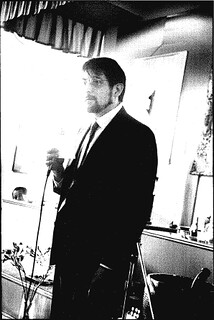 Paula Litsky Bob Rosenthal at Ginsberg’s funeral.
Paula Litsky Bob Rosenthal at Ginsberg’s funeral.It’s the last day of National Poetry Month, so here’s the final installment of our interview with Bob Rosenthal, conducted at Allen Ginsberg’s old 12th Street apartment, where Mr. Rosenthal worked as his secretary for nearly two decades. (Parts one, two, and three of this leisurely conversation ran last week.) As Ginsberg grew older and ill, his assistant followed him to a 14th Street loft purchased from the painter Larry Rivers; when Ginsberg died in 1997, Mr. Rosenthal became executor of the poet’s estate and guardian of one of his last meals.
Allen’s Addictions
Allen always had some pot around – he was a pot propagandist and so if a joint was being passed around and someone was going to take a photograph he would grab the joint so he’s got it. But actually, I rarely ever saw him smoke. He had pot for boyfriends – it’s a good line: “Oh, you want to come up and smoke?” It was really for them. He would go to LSD conventions with the big guys – the Fitz Hugh Ludlow Library guys, Huxley and all those guys. They would give him acid and he would come home and put it in the refrigerator and that was cute. There was a little vial of LSD and it said “Do not take without permission of Allen or Bob” – so I guess Bob had permission. So that was nice. But I never saw him on LSD. Read more…
Panos VikatosClick the middle arrows to see four possible versions.
A new six-story building with condominiums on each floor is coming to Alphabet City.
 Stephen Rex Brown 227 East Seventh Street.
Stephen Rex Brown 227 East Seventh Street.The building, expected to be completed in the summer of next year, will replace a vacant one-story building at 227 East Seventh Street, near Avenue C. Plans to demolish the existing building, which was built around 1980, were approved by the Department of Buildings late last month.
The new structure also spells the end of a big Jim Joe tag. An email to the ubiquitous artist seeking comment bounced back. Read more…
Photos: Lauren Carol Smith
Today, Noah Bernamoff and his wife Rae Cohen, the owners of Montreal-style deli Mile End, opened their first Manhattan venture – a sandwich-only storefront on Bond Street near Bowery. Don’t be surprised if it ends up luring fressers away from the lines at Katz’s.
The menu reprises many of the deli sandwiches (including the classic: smoked meat) that quickly gave the small restaurant instant golden-child status when it opened in Boerum Hill in 2010. There will also be hand-held twists on plated classics: instead of in a bowl, chicken liver will come loaded onto rolls with pickled eggs, duck jus and parsley salad. Read more…
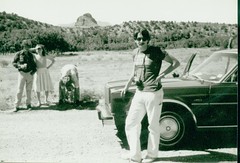 Allen Ginsberg Bob Rosenthal, front. Back, from left: Gregory
Allen Ginsberg Bob Rosenthal, front. Back, from left: Gregory
Corso, Shelley Kraut, and Peter Orlovsky holding
Aliah Rosenthal. 1980. .As National Poetry Month winds down, let’s hear more from Bob Rosenthal. Earlier, in the first and then the second installment of our interview conducted at Allen Ginsberg’s former apartment on East 12th Street, where Mr. Rosenthal worked as his secretary for nearly two decades, we heard about Ginsberg’s daily routine, his social sphere, and his love of the East Village. Now, Mr. Rosenthal recalls the poet’s romantic life, his way with strangers, and his tumultuous relationship with Peter Orlovsky – fellow poet, former lover, and longtime companion.
Allen and Peter
Harry Smith would be living here and walking through and making films, and Peter Orlovsky’s brother Julius would be here. I would listen to music and then Julius would say, “Bob, would you like me to turn the music off?” and I’d say, “No, Julius, I’m enjoying this music,” and then 30 seconds later he’d say, “Bob, would you like me to turn this music off?” And after a couple of times I’d say, “Okay, Julius, I have an idea: why don’t you turn the music off?” Denise [Mercedes] and her bandmates would try to get Julius to swear and they’d try to trick him but he was so smart and they could never trick him into saying a swear word. It was really kind of zany. Read more…
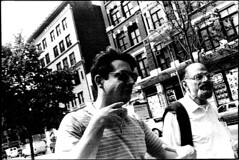 Rosenthal and Ginsberg.
Rosenthal and Ginsberg.Earlier this week, Allen Ginsberg’s secretary of 20 years, Bob Rosenthal, shared memories of his former employer – some of which will be included in a memoir he recently completed, “Straight Around Allen.” Speaking to The Local at Ginsberg’s former apartment on East 12th Street, where the two worked alongside each other for so long, he recalled the great poet’s daily routine, his tastes in literature and music, his mail and telephone communications, and his ways with money. Today, in our second installment, Mr. Rosenthal talks about Ginsberg’s social sphere during his two decades in the so-called poets building. Check back tomorrow for still more from this candid interview.
Allen’s East Village
People would always call Allen and say, “Allen, come to my shangri-la in Hawaii,” and here or there. He would never go. A vacation for Allen was coming back and having nothing to do in the East Village. He would often go to the poetry readings at St. Mark’s. He loved the mushroom barley soup at the Kiev. And The New York Times – he just loved it. He hung around Tompkins Square, wrote a lot of one-line poems about skinheads there. And he was a natural. I think because he always felt free here. Read more…
A pair of items offer a rare bit of good news for those who rent. First, a change in policy in the New York State Unified Court System will eliminate easy access to so-called tenant blacklists, The Village Voice reports. Landlords have been able to buy the lists of people who participated in housing court cases from a third party as a way to weed out troublesome tenants. Now, plaintiffs and defendants in court cases will remain in the public record, but the lists of names in bulk will no longer be available for purchase online. Concern over the blacklists is real: it even came up in the comments of our coverage of the landlord-tenant fight brewing on East Third Street. In other news, the Post reports that the annual rent increase for rent-stabilized apartments will likely be the smallest its been since 2002.


















